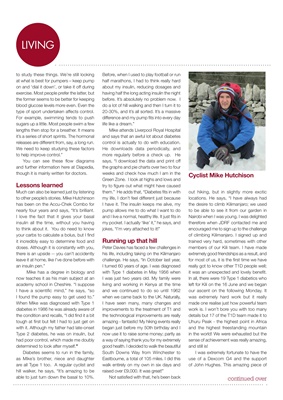
LIVINGLIVING
to study these things. We're still looking
at what is best for pumpers - keep pump
on and 'dial it down', or take it off during
exercise. Most people prefer the latter, but
the former seems to be better for keeping
blood glucose levels more even. Even the
type of sport undertaken affects control.
For example, swimming tends to push
sugars up a little. Most people swim a few
lengths then stop for a breather. It means
it's a series of short sprints. The hormonal
releases are different from, say, a long run.
We need to keep studying these factors
to help improve control."
You can see these flow diagrams
and further information here at Diapedia,
though it is mainly written for doctors.
Lessons learned
Much can also be learned just by listening
to other people's stories. Mike Hutchinson
has been on the Accu-Chek Combo for
nearly four years and says, "It's brilliant.
I love the fact that it gives your basal
insulin all the time, without you having
to think about it. You do need to know
your carbs to calculate a bolus, but I find
it incredibly easy to determine food and
doses. Although it is constantly with you,
there is an upside -- you can't accidently
leave it at home, like I've done before with
an insulin pen."
Mike has a degree in biology and
now teaches it as his main subject at an
academy school in Cheshire. "I suppose
I have a scientific mind," he says, "so
I found the pump easy to get used to."
When Mike was diagnosed with Type 1
diabetes in 1986 he was already aware of
the condition and recalls, "I did find it a bit
tough at first but felt I had to just get on
with it. Although my father had late-onset
Type 2 diabetes, he was on insulin, but
had poor control, which made me doubly
determined to look after myself."
Diabetes seems to run in the family,
as Mike's brother, niece and daughter
are all Type 1 too. A regular cyclist and
hill walker, he says, "It's amazing to be
able to just turn down the basal to 10%.
Before, when I used to play football or run
half marathons, I had to think really hard
about my insulin, reducing dosages and
having half the long acting insulin the night
before. It's absolutely no problem now. I
do a lot of hill walking and then I turn it to
20-30%, and it's all sorted. It's a massive
difference and my pump fits into every day
life like a dream."
Mike attends Liverpool Royal Hospital
and says that an awful lot about diabetes
control is actually to do with education.
He downloads data periodically, and
more regularly before a check up. He
says, "I download the data and print off
the graphs and pie charts over two to four
weeks and check how much I am in the
Green Zone. I look at highs and lows and
try to figure out what might have caused
them." He adds that, "Diabetes fits in with
my life, I don't feel different just because
I have it. The insulin keeps me alive, my
pump allows me to do what I want to do
and I live a normal, healthy life. It just fits in
my pocket. I actually 'like' it," he says, and
jokes, "I'm very attached to it!"
Running up that hill
Peter Davies has faced a few challenges in
his life, including taking on the Kilimanjaro
challenge. He says, "In October last year,
I turn 60 years of age. I was diagnosed
with Type 1 diabetes in May 1956 when
I was just two years old. My family were
living and working in Kenya at the time
and we continued to do so until 1962
when we came back to the UK. Naturally,
I have seen many, many changes and
improvements to the treatment of T1 and
the technological improvements are really
amazing - fantastic! My hiking events really
began just before my 50th birthday and I
now use it to raise some money; partly as
a way of saying thank you for my extremely
good health. I decided to walk the beautiful
South Downs Way from Winchester to
Eastbourne, a total of 105 miles. I did this
walk entirely on my own in six days and
raised over £9,000. It was great!"
Not satisfied with that, he's been back
but in slightly more exotic locations. He
says, "I have always had the desire to
climb Kilimanjaro; we used to be able to
see it from our garden in Nairobi when I
was young. I was delighted therefore when
JDRF contacted me and encouraged me
to sign up to the challenge of climbing
Kilimanjaro. I signed up and trained very
hard, sometimes with other members
of our Kili team. I have made extremely
good friendships as a result, and for most
of us, it is the first time we have really got
to know other T1D people well; it was
an unexpected and lovely benefit. In all,
there were 19 Type 1 diabetics who left
for Kili on the 16 June and we began our
ascent on the following Monday. It was
extremely hard work but it really made
one realise just how powerful team work
is. I won't bore you with too many details
but 17 of the T1D team made it to Uhuru
Peak - the highest point in Africa and
the highest freestanding mountain in the
world! We were exhausted but the sense
of achievement was really amazing, and
still is!
I was extremely fortunate to have the
use of a Dexcom G4 and the wonderful
support of John Hughes (what a nice guy!).
Cyclist Mike Hutchison
continued over